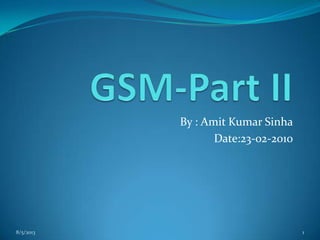
GSM introduction
- 1. By : Amit Kumar Sinha Date:23-02-2010 8/5/2013 1
- 2. History……Yaaaaawn When the acronym GSM was used for the first time in 1982, it stood for Groupe Spéciale Mobile, a committee under the umbrella of Conférence Européenne des Postes et Télécommunications (CEPT), the European standardization organization. The task of GSM was to define a new standard for mobile communications in the 900 MHz range. It was decided to use digital technology. In the course of time, CEPT evolved into a new organization, the European Telecommunications Standard Institute (ETSI). The first GSM network was launched in 1991 by Radiolinja in Finlandwith joint technical infrastructure maintenance from Ericsson. 8/5/2013 2
- 3. GSM Present…… 8/5/2013 3 2,449,937309,907,068118,688,849 3,450,410,548 255,630,141133,286,097825,044 1,480,766 9,5930 500,000,000 1,000,000,000 1,500,000,000 2,000,000,000 2,500,000,000 3,000,000,000 3,500,000,000 cdmaOne CDMA2K 1X EVDO GSM WCDMA WCDMA HSPA TD- SCDMA TDMA Analog Connections by Bearer Technology 0 500,000,000 1,000,000,000 1,500,000,000 2,000,000,000 2,500,000,000 A frica A m erica s A sia P acificE uro pe:E aste rnE uro pe:W estern M iddle E ast U S A /C ana da Series1
- 4. GSM Architecture: Interface Types 8/5/2013 4
- 5. GSM Air Interface Bursts Each carrier frequency used in GSM is divided into 8 independent timeslots and into each of these timeslots a burst is placed. The diagram shows the general format of a GSM burst. The receiver can only receive the burst and decode it if it is received within the timeslot designated for it. The timing, therefore, must be extremely accurate, however, the structure does allow for a small margin of error by incorporating a ‘guard period’ as shown in the diagram. To be precise, the timeslot is 0.577ms long, whereas the burst is slightly shorter at 0.546ms. Eight bursts occupy one TDMA frame. The ‘‘flag-bits” are set when the frame has been ‘stolen’ by FACCH (the Fast Associated Control Channel). The ‘‘training sequence” is used by the receiver’s equaliser as it estimates the transfer characteristic of the physical path between the base-station and the mobile. 8/5/2013 5
- 8. GSM Control Channels 8/5/2013 8 SHOLAY Thakur JaiVeeru Gabbar Basanti Sambha Jailor Mausi Ramlal
- 14. Erlang B One Erlang is a measure of one traffic channel permanently occupied at busy hour. For example busy hour (if measured for hourly basis) in Bangalore occurs twice in 24 hrs. Generally between 10 am to 11 am and 8 pm to 9pm. Then if I say 0.25 Erl corresponds to 1 resource occupied for 25 % of time(i.e. 15 minutes in our case) 8/5/2013 14
- 15. How is Erlang calculated??? 8/5/2013 15 25 mE 10 mE 5 mE
- 16. TCH Calculation 8/5/2013 16 Max. traffic/subscriber at busy hour = 25 mE No. of subscriber = 1700 Then planned traffic in cell including the 1700 subscriber=42.5 Erlang No. of necessary resources with a blocking rate of 2% obtained from Erlang B table = 53 resources TCH channels = 53 for 42.5 Erlang
- 17. SDCCH Calculation 8/5/2013 17 Now for SDCCH calculation, If TCH = 42.5 Erlang then SDCCH = 28% of TCH (i.e. 42.5)= 11.9 Erlang So the no. of SDCCH resources at 0.1% blocking rate = 24 (from table) No. of SDCCH = 24/8 = 3 SDCCH TS
- 18. TRX Calculation 8/5/2013 18 No. of CCCH required = 1 per cell Therefore we can conclude now That , total no. of TS required = 53 + 3 + 1 = 57 Total of TRX= 57 / 8 = 8 (rounding to upper limit)
- 19. Site Dimensioning 8/5/2013 19 42.5 Erlang giving us 8 TDMA or TRXs Cell 1 Cell 2 Cell 3
- 20. References 8/5/2013 20 GSM Networks: Protocols, Terminology and Implementation – by Gunnar Heine www.etsi.org
- 21. Those who are sleeping, its time to wake up and clap and for those who aren’t BIG THANK YOU 8/5/2013 21